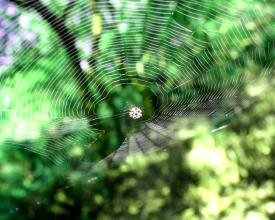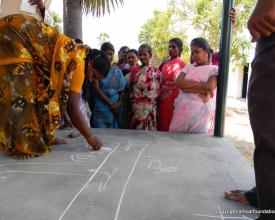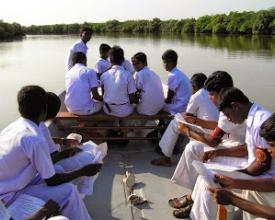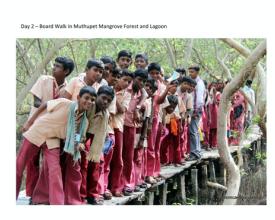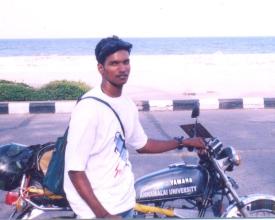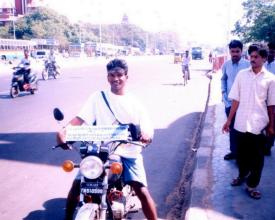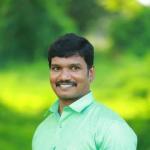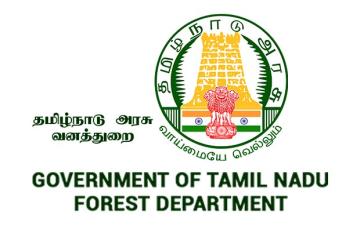
Restauration de la mangrove pour une pêche durable dans la baie de Palk, Inde
La dégradation des mangroves dans notre région est due à un manque de sensibilisation aux avantages des mangroves. Considérées comme du bois de chauffage, elles ont été détruites pour l'élevage de crevettes et le pâturage du bétail. Il n'existe pas d'approche systématique et participative de la restauration des mangroves dans la baie de Palk. Notre organisation cherche donc à résoudre ce problème en sensibilisant la communauté locale et en l'impliquant dans des pratiques participatives de conservation des mangroves dans la baie de Palk.
Contexte
Défis à relever
La dégradation des mangroves dans notre région est due à un manque de sensibilisation aux avantages des mangroves, considérées comme du bois de chauffage, éradiquées pour l'élevage de crevettes et le pâturage du bétail. Il n'existe pas d'approche systématique et participative de la restauration des mangroves dans la baie de Palk. Nous cherchons donc à résoudre ce problème en sensibilisant la communauté locale et en l'impliquant dans des pratiques participatives de conservation des mangroves.
Emplacement
Traiter
Résumé du processus
Blocs de construction
Pépinières et plantations participatives de palétuviers
Nous avons formé la communauté locale à la collecte de semences, aux techniques d'élevage en pépinière et à la plantation sur des sites sélectionnés en utilisant des stratégies adaptables localement et des techniques peu coûteuses. Nous avons organisé des réunions de village afin d'identifier les sites sélectionnés pour la restauration de la mangrove, sans perturber la vie quotidienne des pêcheurs. Nous avons impliqué des volontaires de la communauté locale pour clôturer les zones de mangrove afin d'empêcher le pâturage du bétail et placer des panneaux publics comme site protégé. Pendant la saison propice, des bénévoles de la communauté locale ont participé à la collecte de graines de mangrove, en particulier des groupes de femmes impliquées dans la collecte et la ségrégation des graines de mangrove. Les pêcheurs ont participé à la construction de pépinières de palétuviers.
Facteurs favorables
Nous avons formé la communauté locale à la collecte de semences, aux techniques d'élevage en pépinière et à la plantation dans des sites sélectionnés en utilisant des stratégies adaptables localement et des techniques peu coûteuses. Nous avons organisé des réunions dans les villages afin d'identifier les sites de restauration des mangroves, sans perturber la vie quotidienne des pêcheurs. Nous avons impliqué des volontaires de la communauté locale pour clôturer les zones de mangrove afin d'empêcher le pâturage du bétail et placer des panneaux publics comme site protégé. Pendant la saison propice, des bénévoles de la communauté locale ont participé à la collecte de graines de mangrove, en particulier des groupes de femmes.
Leçon apprise
Tout projet de conservation marine doit être à long terme, participatif, faire appel à des technologies peu coûteuses et être orienté vers la communauté ; il doit être conçu par des experts locaux en collaboration avec les dirigeants de la communauté. Les connaissances traditionnelles doivent être intégrées lors de l'élaboration des techniques de conservation, telles que les techniques de plantation de mangroves.
- Sélection d'espèces de mangroves appropriées, de sites de restauration appropriés et d'une saison de plantation adéquate. La stratégie doit être formée sur la base des trois aspects ci-dessus.
- Les graines doivent être collectées au bon moment, avant la mousson, sinon elles seront rejetées dans la mer par la mousson.
- Il ne faut jamais procéder à des plantations massives de mangroves, ce qui entraînerait un gaspillage des ressources et des plantes. Au lieu de cela, il faut planter lentement des palétuviers à chaque saison sur des sites sélectionnés et reconnus par la communauté locale, faute de quoi il n'y aura plus de palétuviers après quelques années.
Cartographie SIG participative des mangroves et de l'utilisation des sols
Il n'existe pas de données claires sur la propriété foncière et les zones de mangrove dans les villages côtiers de la zone du projet. Nous avons donc développé des techniques de cartographie SIG simples et peu coûteuses, qui nécessitent la participation de la communauté locale pour être affichées dans les salles communautaires des villages. Cette technique a permis d'établir une carte complète de l'utilisation des terres dans les villages côtiers, qui aide à localiser les sites de plantation de mangroves, à prévenir les inondations et à contrôler l'extension des élevages de crevettes. Cette carte a également servi d'outil clé pour comprendre mutuellement l'utilisation des terres du village, la conservation et le développement durable entre les habitants et le gouvernement local. La même expertise technique a été utilisée pour créer une carte SIG des limites de la forêt de mangroves protégée de Muthupet dans la baie de Palk, d'une superficie d'environ 13 000 hectares carrés.
Facteurs favorables
Les principales conditions sont les suivantes
- Former les villageois au relevé GPS
- Organiser des réunions publiques, afin que les bénéficiaires comprennent la valeur réelle de ce concept
- Impliquer des volontaires dans l'élaboration de cartes SIG
- Affichage des cartes dans les lieux publics et les salles communautaires en grand format (5 x 4 pieds) pour une utilisation régulière.
- Plantation de mangroves uniquement dans la zone sélectionnée par les personnes ayant développé les mangroves.
- La planification locale de la conservation des mangroves est facile pour les agents forestiers sur le terrain, après avoir développé notre carte SIG.
Leçon apprise
La cartographie SIG à faible coût est un processus très lent.
- Il est essentiel d'entretenir des relations étroites avec la communauté
- Les connaissances traditionnelles sont très importantes en ce qui concerne les modes d'utilisation des terres locales.
- Les groupes de femmes jouent un rôle essentiel dans l'élaboration des cartes.
- De bonnes relations avec le département local des forêts sont essentielles pour montrer notre intérêt non lucratif pour l'élaboration de cartes SIG de la mangrove.
Pépinière de mangrove en arrière-cour
Il y a deux faits essentiels :
- Il est difficile et coûteux d'élever un grand nombre de pépinières de mangroves.
- La responsabilité de la communauté dans la conservation de la mangrove doit être incluse pour que le projet soit couronné de succès.
Notre objectif est donc d'impliquer les groupes d'entraide de femmes pêcheurs dans la conservation de la mangrove en les formant aux techniques de culture de la mangrove et en cultivant un grand nombre de mangroves dans les arrière-cours de tous les ménages du village. Cette approche a permis de partager la main d'œuvre nécessaire à la culture de la mangrove et d'accroître la responsabilité de la communauté dans le cadre de notre projet. Les plants de palétuviers qui ont poussé sont ensuite apportés à notre pépinière au bout de trois mois. Toutes les femmes qui cultivent des palétuviers dans leur jardin ont reçu des primes pour chaque plant de palétuvier. Le même groupe de femmes a été invité à suivre une formation sur la mangrove et à participer à un événement de plantation de mangrove sur la côte locale. Cette participation continue des groupes de femmes a permis de partager les responsabilités et la charge de travail et de procurer des avantages financiers à la communauté locale.
Facteurs favorables
Les connaissances techniques et l'expertise en matière de restauration des mangroves sont très importantes pour élever les mangroves et les planter sur les côtes locales. Les connaissances techniques doivent être associées aux connaissances traditionnelles lors de la sélection des sites. Outre les techniques, il faut un engagement fort et une volonté de communiquer avec les groupes de femmes locales pour qu'elles viennent apprendre et planter des palétuviers.
Leçon apprise
Les mangroves dégradées peuvent être transformées en taillis forestiers sains grâce à un engagement à long terme, aux techniques et à la participation de la communauté locale. Aucune plantation de mangrove ne doit être réalisée en grand nombre, ce qui ne servirait qu'à faire de la publicité, mais plus tard, les mangroves ne survivront pas dans des sites inadaptés. Le projet de restauration de la mangrove ne sera pas couronné de succès si l'on ne sélectionne pas correctement les sites en utilisant les connaissances traditionnelles.
Ressources
Excursions de sensibilisation à la mangrove et éducation pour les écoles
L'objectif est d'attirer davantage de volontaires pour la restauration des mangroves et la conservation marine dans la baie de Palk en sensibilisant les jeunes, en particulier les écoliers. Nous approchons les écoles locales et expliquons l'objectif aux enseignants. Ensuite, notre équipe organise des cours sur les écosystèmes marins locaux, en particulier sur les mangroves et les herbiers marins de la baie de Palk (la zone du projet). Après ce cours, nous invitons environ 70 élèves de chaque école à notre centre d'éducation environnementale sur le terrain, appelé "OMCAR Palk Bay Environmental Education Centre", et à une excursion dans les mangroves. Après cette excursion, les élèves intéressés rejoignent notre organisation en tant que bénévoles et participent à diverses activités de conservation sur le terrain, telles que des enquêtes sur les mangroves des villages, des entretiens sur la conservation des dugongs, l'organisation d'événements communautaires et la cartographie SIG participative des mangroves et des schémas d'utilisation des sols.
Facteurs favorables
Les étudiants ne devraient être organisés que par le biais de structures systématiques telles que les écoles, avec le soutien des autorités locales. Au fur et à mesure que les élèves passeront dans des classes supérieures, il sera nécessaire de continuer à organiser des événements de sensibilisation pour les nouveaux groupes chaque année. Les élèves du collège sont très bien placés pour être sensibilisés à la conservation du milieu marin (14-16 ans). Des sorties sur le terrain devraient être organisées en accordant une grande importance à la sécurité dans les zones côtières et marines. En outre, les élèves qui ont abandonné l'école et les jeunes pêcheurs peuvent être invités avec les élèves.
Leçon apprise
Après avoir rejoint les volontaires, l'énergie humaine des volontaires doit être utilisée et rafraîchie périodiquement, ce qui peut réduire considérablement le coût de la main d'œuvre du projet. Les installations physiques de notre organisation, telles que les équipements et les bâtiments, sont en très bon état après avoir été continuellement utilisées par des milliers d'étudiants chaque année. C'est pourquoi toute prise de conscience devrait conduire à la mise en place d'installations permanentes et non pas seulement d'un événement d'un jour.
Attirer le public vers la conservation par des expéditions
C'était vraiment repousser les limites au-delà de mes capacités, après avoir parcouru 1100 km à vélo en 2002 et 600 km en kayak de mer en 2007. L'objectif est de sensibiliser le public à la conservation marine par le biais de la télévision et de la presse écrite et de lui faire prendre conscience de la valeur de nos écosystèmes côtiers locaux. En 2007, j'ai pagayé en kayak de mer le long de la côte sur environ 20 km chaque jour et j'ai atteint un village voisin. Je suis resté sur la plage et j'ai donné des cours d'éducation à la conservation marine sur les rivages, les plages, les salles communautaires, les maisons et les écoles. Après avoir passé du temps avec ces villageois et enregistré quelques volontaires pour notre organisation, j'ai de nouveau longé la côte jusqu'au village suivant. J'ai fait la même sensibilisation lors de mon expédition à vélo de 1100 km le long de la côte de mon État, le Tamil Nadu, en 2002.
Facteurs favorables
Cette sensibilisation d'un seul homme nécessitait une formation et un engagement personnels, en particulier pour le kayak de mer. Un ensemble complet de matériel de sensibilisation au milieu marin, une bonne connaissance de la zone côtière locale et des connaissances traditionnelles des pêcheurs étaient essentiels pour les deux expéditions. Des milliers d'enfants, de villageois et d'étudiants ont été sensibilisés au cours de ces deux expéditions. L'expédition a bénéficié d'une large couverture médiatique, ce qui a permis de faire passer le message de conservation de cette expédition auprès du grand public.
Leçon apprise
L'attention du grand public et des médias peut être attirée sur les questions de conservation marine locale en organisant de telles expéditions. L'expédition doit être bien planifiée et la personne doit être facilement accessible au public tout au long de l'expédition. Un grand nombre de brochures et de documents sur la conservation doivent être distribués au public et aux médias tout au long des expéditions de conservation. L'itinéraire de l'expédition doit être proche des habitants afin d'attirer l'attention du public et des médias sur l'objectif et l'état d'avancement de l'expédition. Expédition à vélo de 1200 km pour la sensibilisation à la conservation marine 2002 Expédition en seakayak de 600 km pour la sensibilisation à la conservation marine en 2007
Impacts
Nous avons planté plus de 75 000 palétuviers et sensibilisé environ 60000 élèves à la conservation du milieu marin. Nos sites de plantation de palétuviers se sont transformés en petites forêts de palétuviers, ce qui profite à la communauté de pêcheurs locale. Les jeunes volontaires formés par notre organisation nous aident à planter des mangroves et à sensibiliser la population. Notre équipe a réussi à créer une carte SIG de l'ensemble de la réserve forestière de Muthupet (zone protégée) avec le département forestier local, ce qui l'aide à mieux la gérer. Notre soutien technique et nos enquêtes sur le terrain ont permis de créer une ligne de démarcation précise le long des bornes pour environ 13 000 hectares. Nos cartes SIG des mangroves au niveau du village sont affichées dans les salles communautaires, ce qui facilite la prise de décision sur les nouveaux sites de plantation de mangroves, la gestion de l'utilisation des terres et la prévention des inondations. Après une bonne reconnaissance de notre approche avec la communauté locale, celle-ci nous a aidés à établir le centre d'éducation à l'environnement de Palk Bay dans un village côtier qui se développe maintenant comme un lieu principal pour la conservation de l'écosystème côtier, la recherche et la sensibilisation dans notre district de Palk Bay.
Bénéficiaires
Pêcheurs et femmes, écoliers, jeunes pêcheurs/jeunes déscolarisés.

